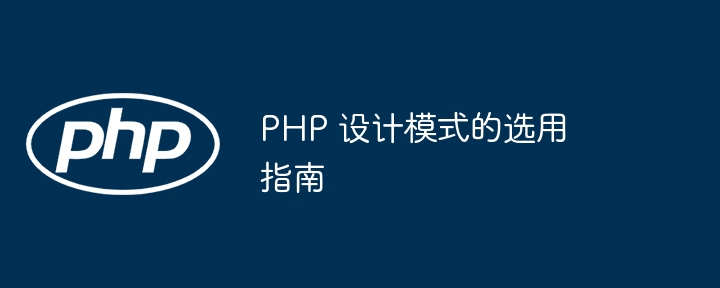Home >Backend Development >PHP Tutorial >A guide to choosing PHP design patterns
A guide to choosing PHP design patterns
- WBOYWBOYWBOYWBOYWBOYWBOYWBOYWBOYWBOYWBOYWBOYWBOYWBOriginal
- 2024-05-06 16:03:01979browse

Guidelines for Choosing PHP Design Patterns
A design pattern is a predefined solution to common programming problems. They are designed to improve code reusability, scalability, and maintainability.
Principles for selecting design patterns
- Problem domain: Design patterns map to specific problem domains.
- Code duplication: Design patterns help reduce code duplication.
- Extensibility: Design patterns make the code easier to extend or modify.
- Maintainability: Design patterns improve the maintainability of code, making it easy to read and understand.
Common PHP design patterns
Creative
- Factory method: Create an object without specifying the specific class of the object.
- Single case mode: Ensure that a class can only have one instance.
- Builder Mode: Create complex objects step by step and easy to customize.
Structural
- Adapter pattern: Enables incompatible objects to work together.
- Bridge mode: Separate the abstract part from the implementation part to improve scalability.
- Combined mode: Group objects into a tree structure to represent the part-whole hierarchy.
Behavioral
- Strategy mode: Change certain behaviors of the object based on different algorithms or strategies.
- Observer mode: When the subject state changes, the observer will automatically receive a notification.
- Chain of responsibility mode: Process the request along the chain of responsibility until an object can handle it.
Practical case: singleton mode
Suppose you are creating an e-commerce website and need a logging class responsible for writing log files. To ensure that there is only one log file, you can use the singleton mode:
class Logger
{
private static $instance;
private $handle;
private function __construct()
{
$this->handle = fopen('log.txt', 'a');
}
public static function getInstance()
{
if (!isset(self::$instance)) {
self::$instance = new Logger();
}
return self::$instance;
}
public function write($message)
{
fwrite($this->handle, $message . "\n");
}
public function close()
{
fclose($this->handle);
}
}
// 使用单例类
$logger = Logger::getInstance();
$logger->write('商品添加成功');
$logger->close();Using the singleton mode, no matter how many requests there are in the website, there is always only one instance of the log file.
The above is the detailed content of A guide to choosing PHP design patterns. For more information, please follow other related articles on the PHP Chinese website!

